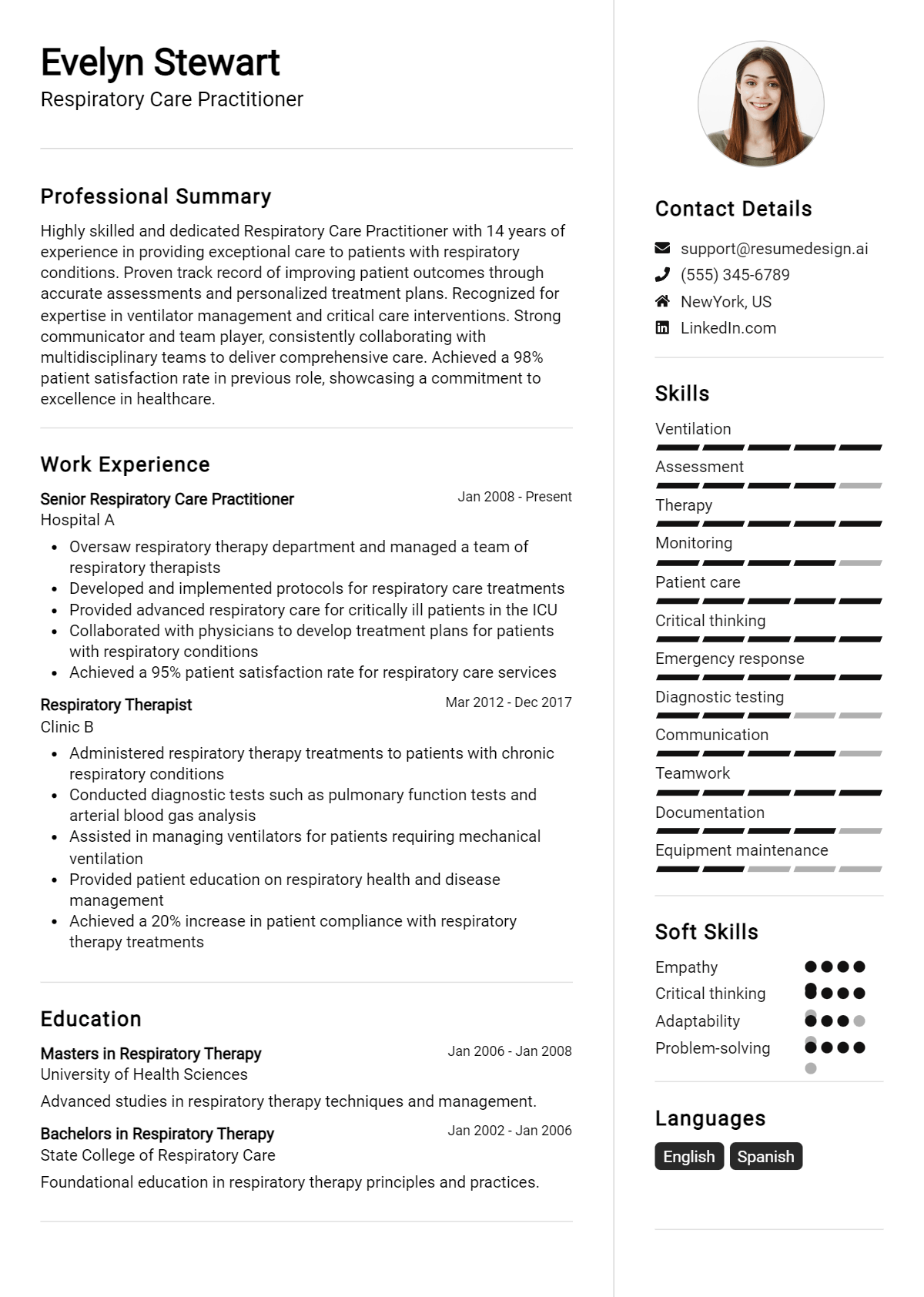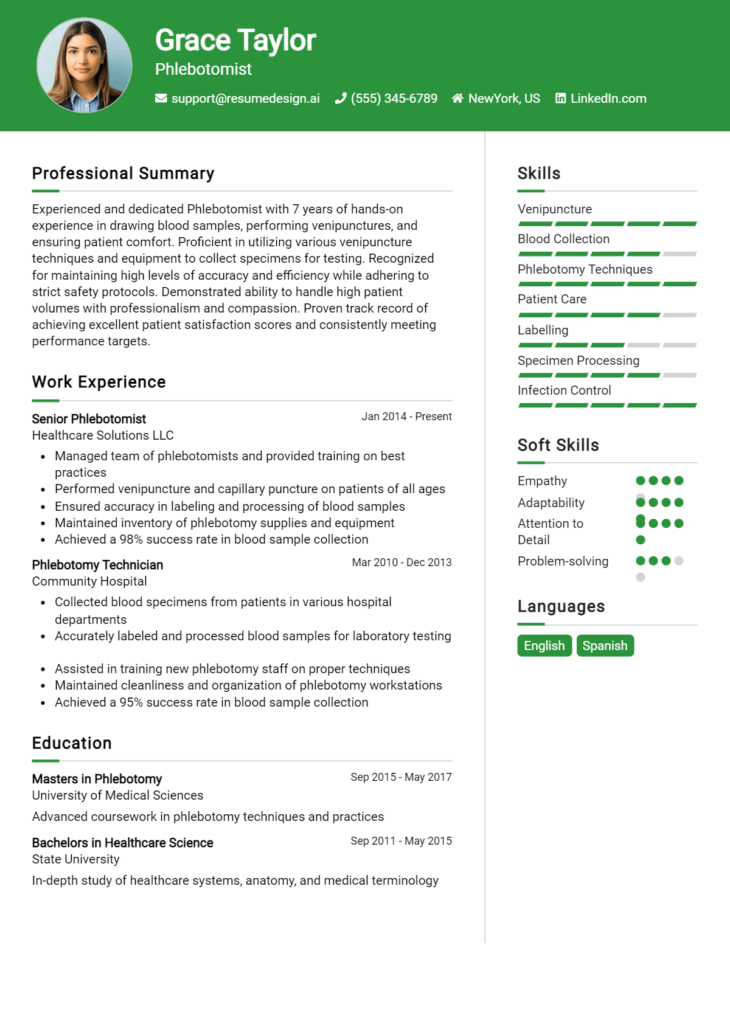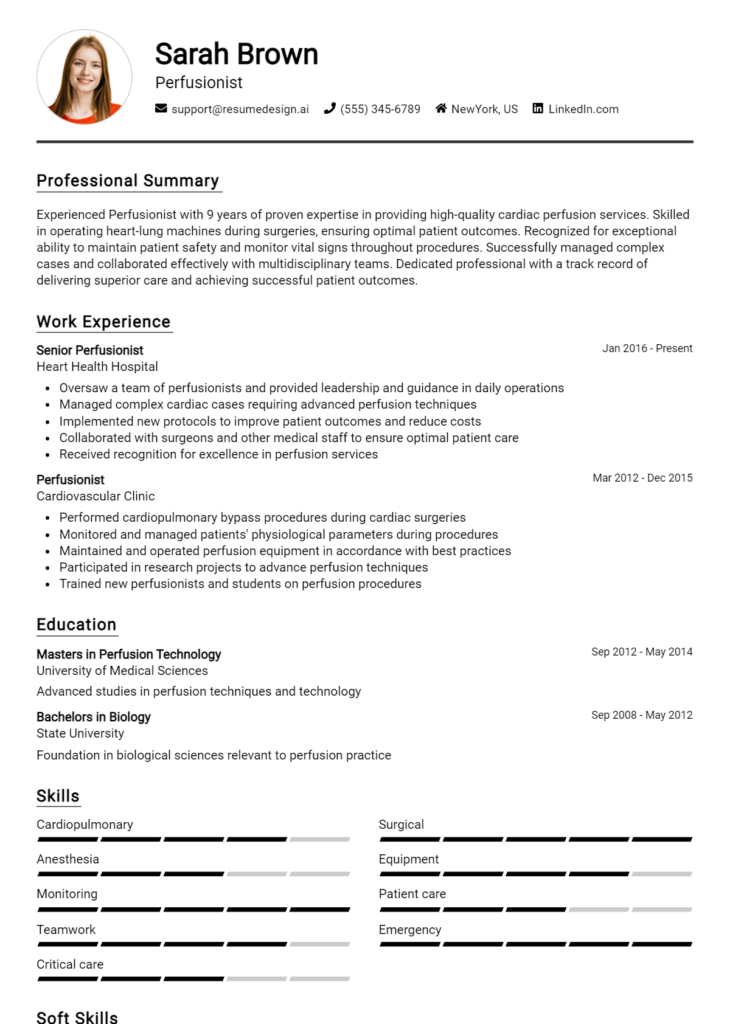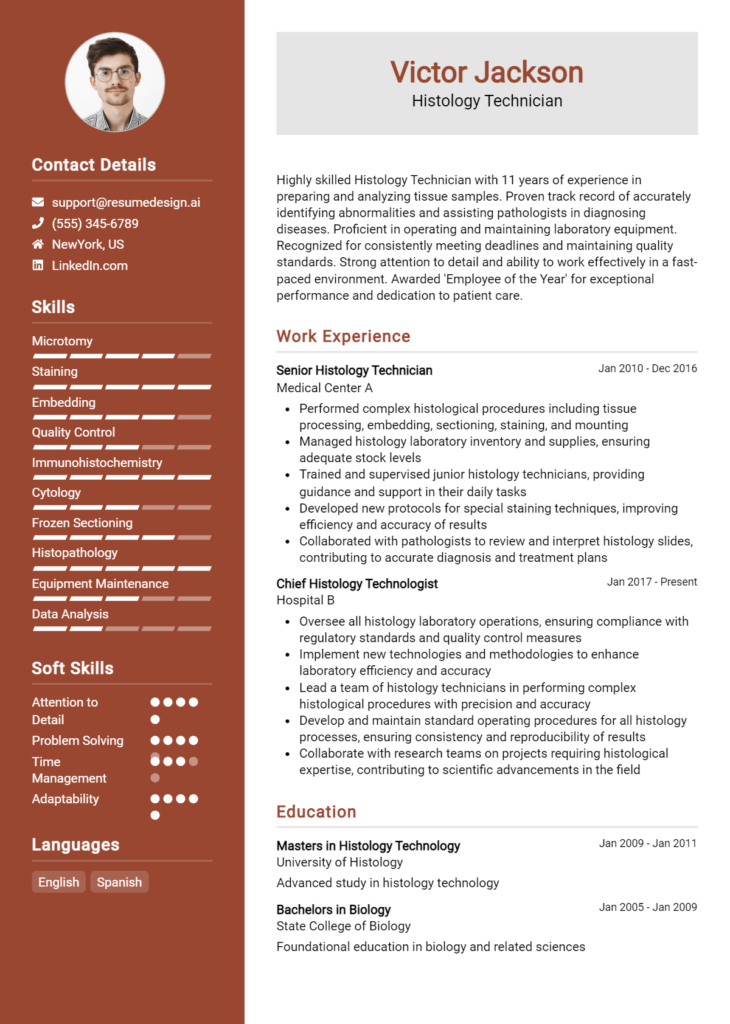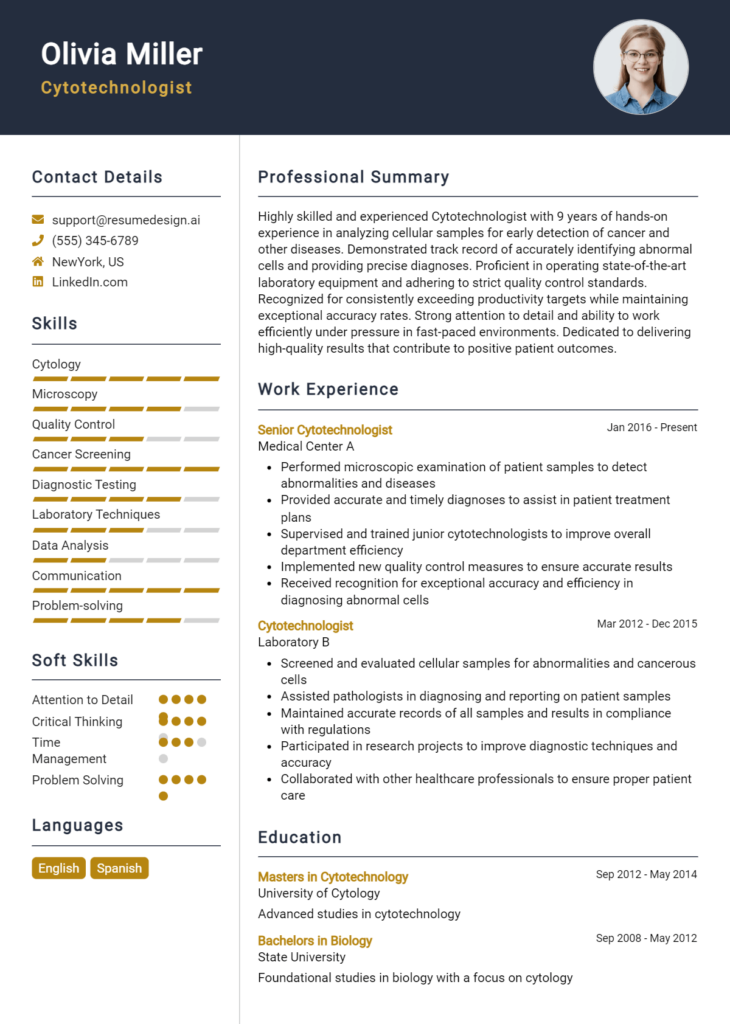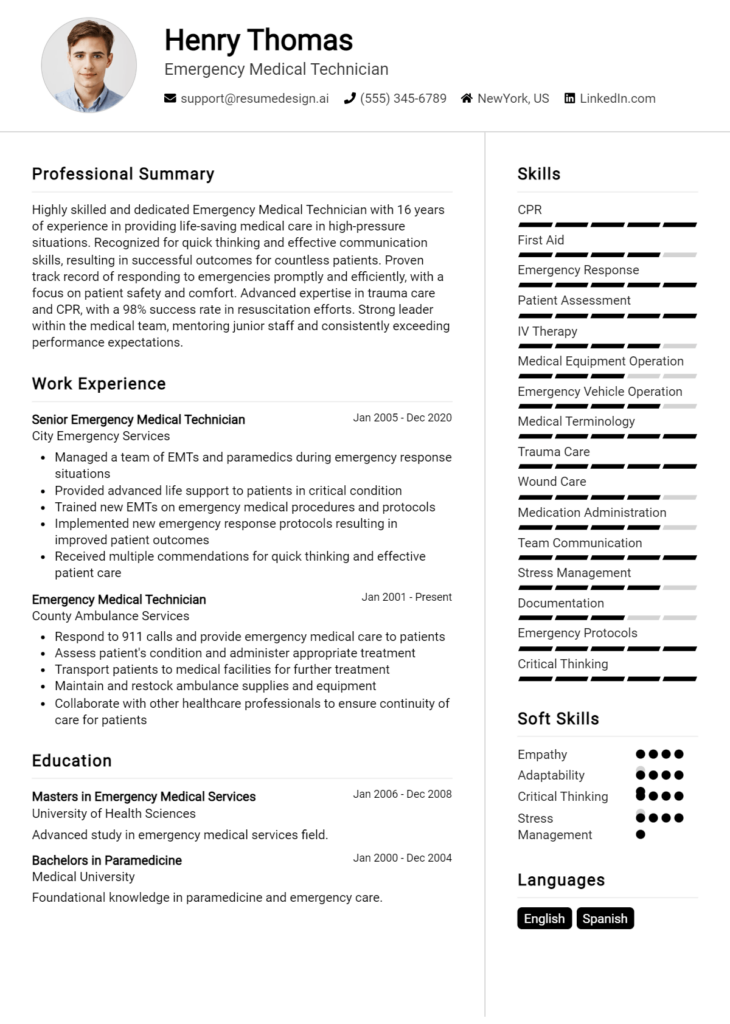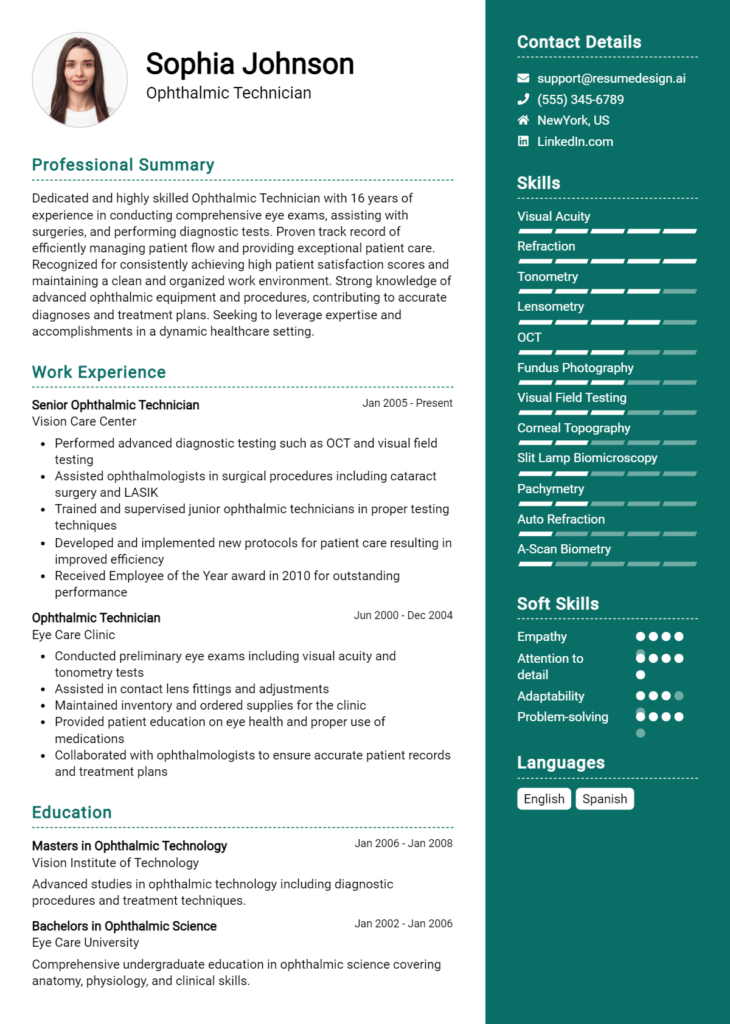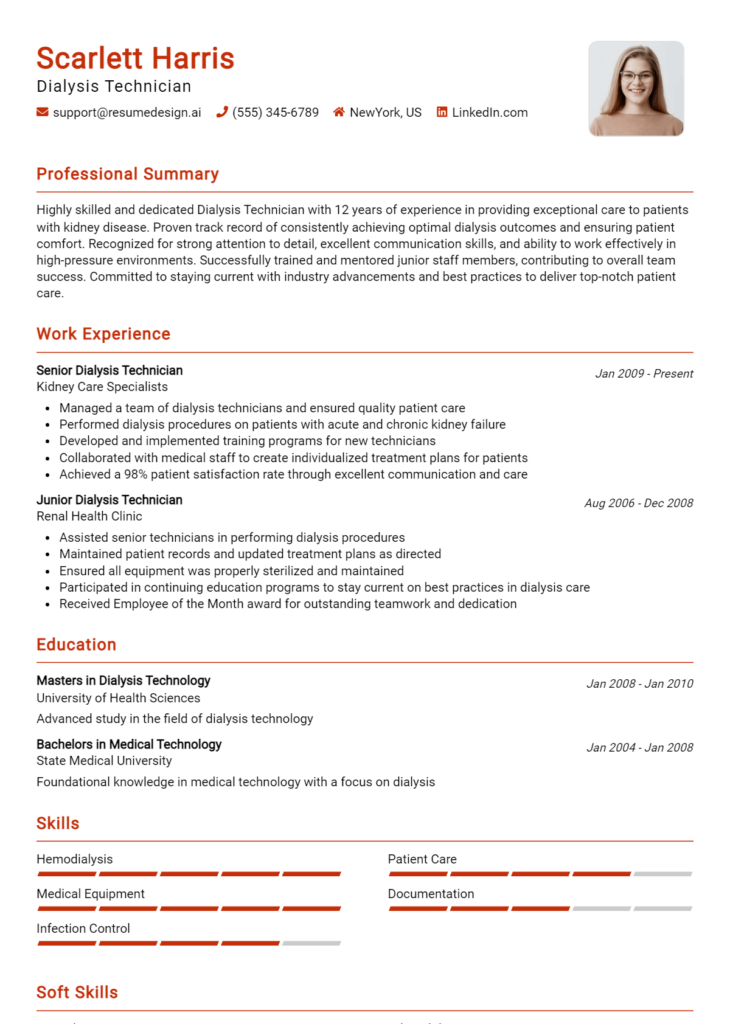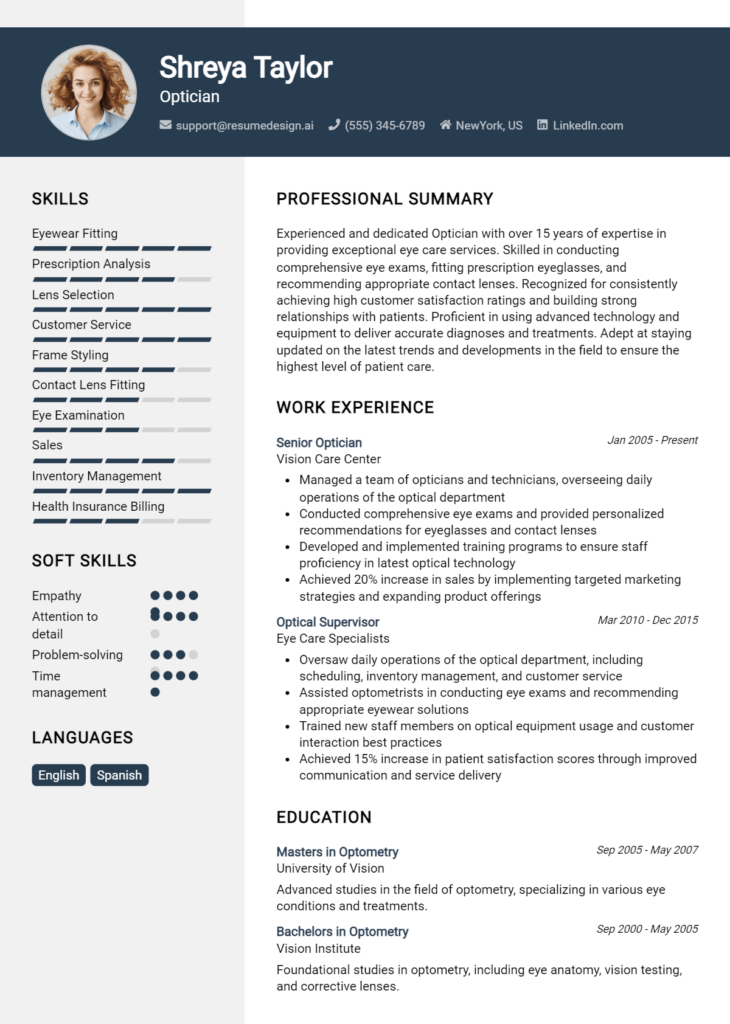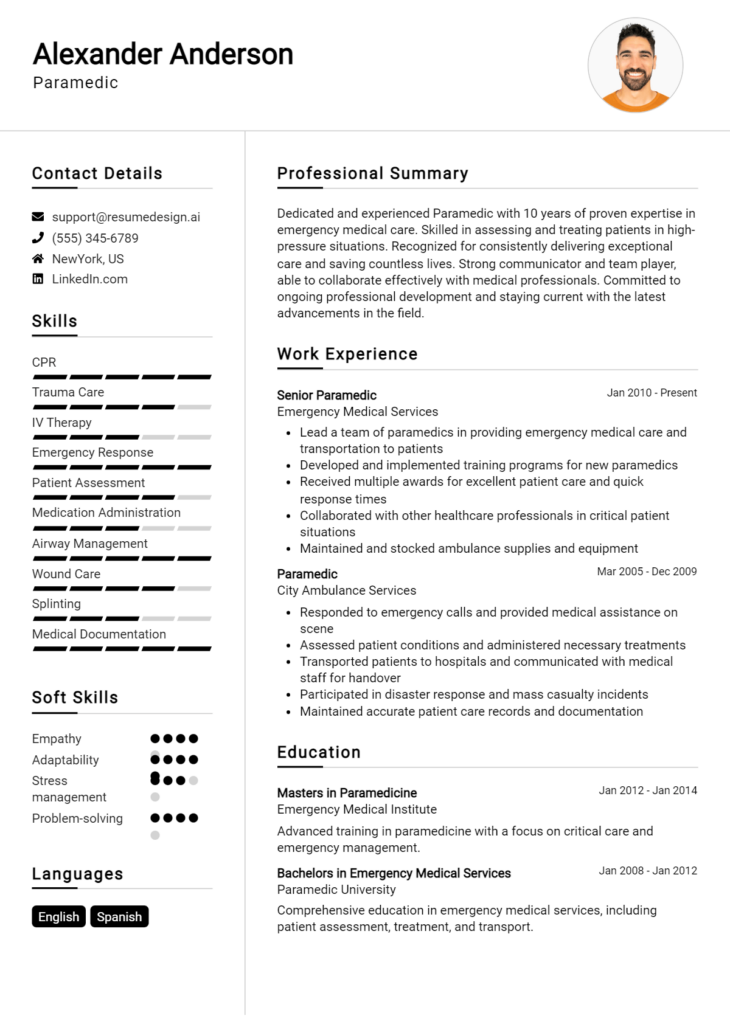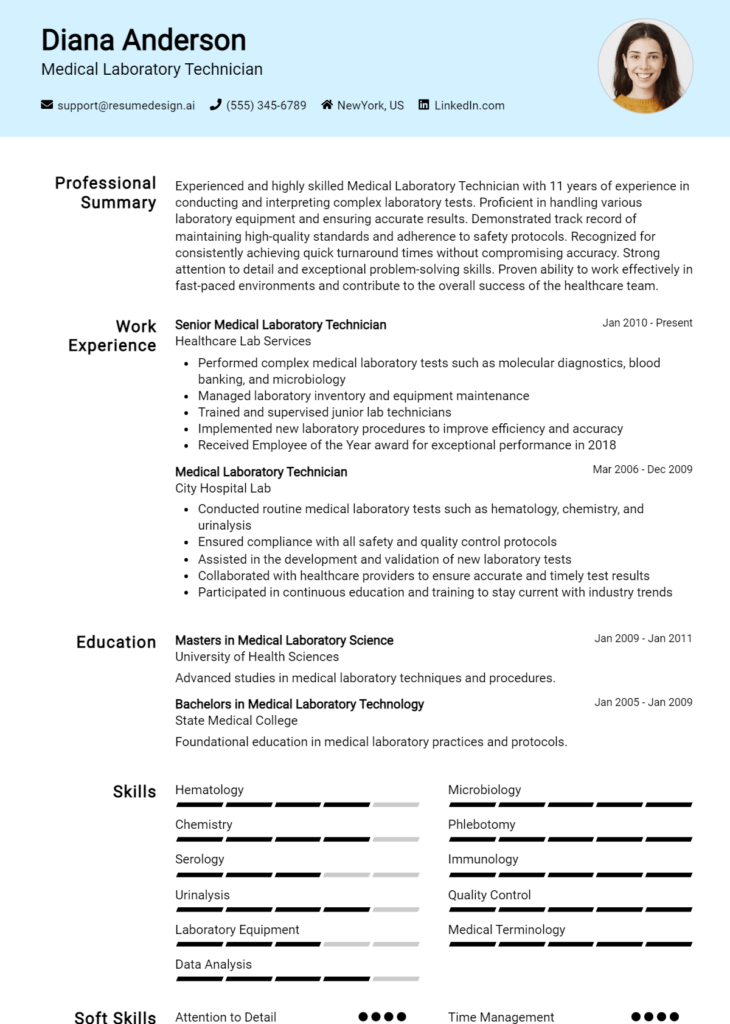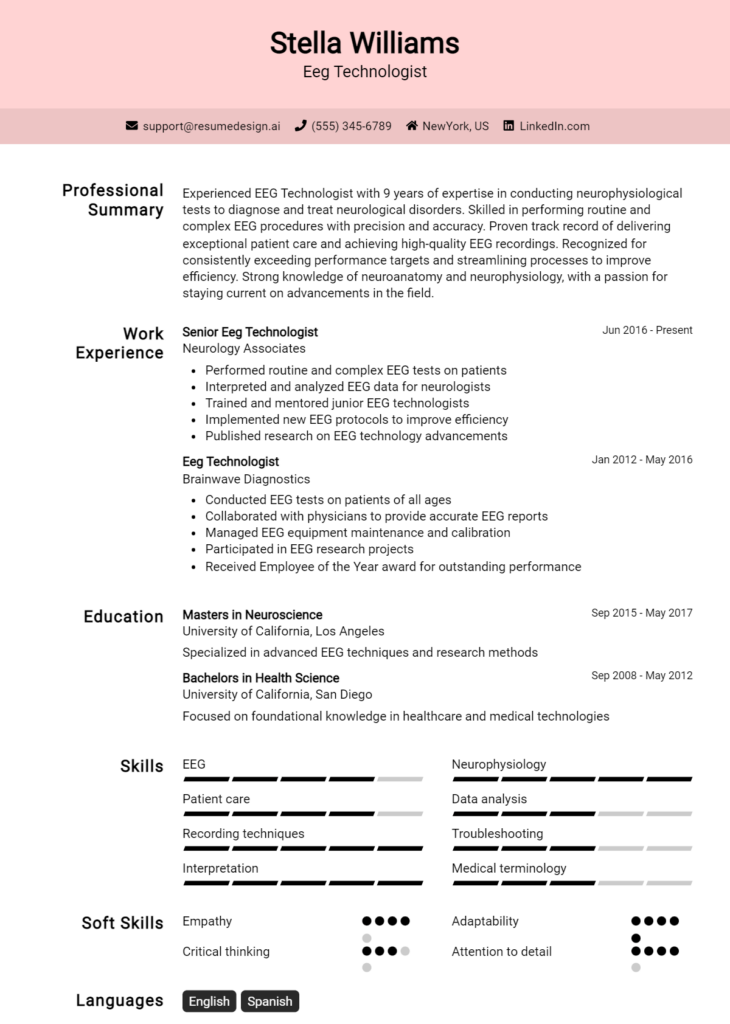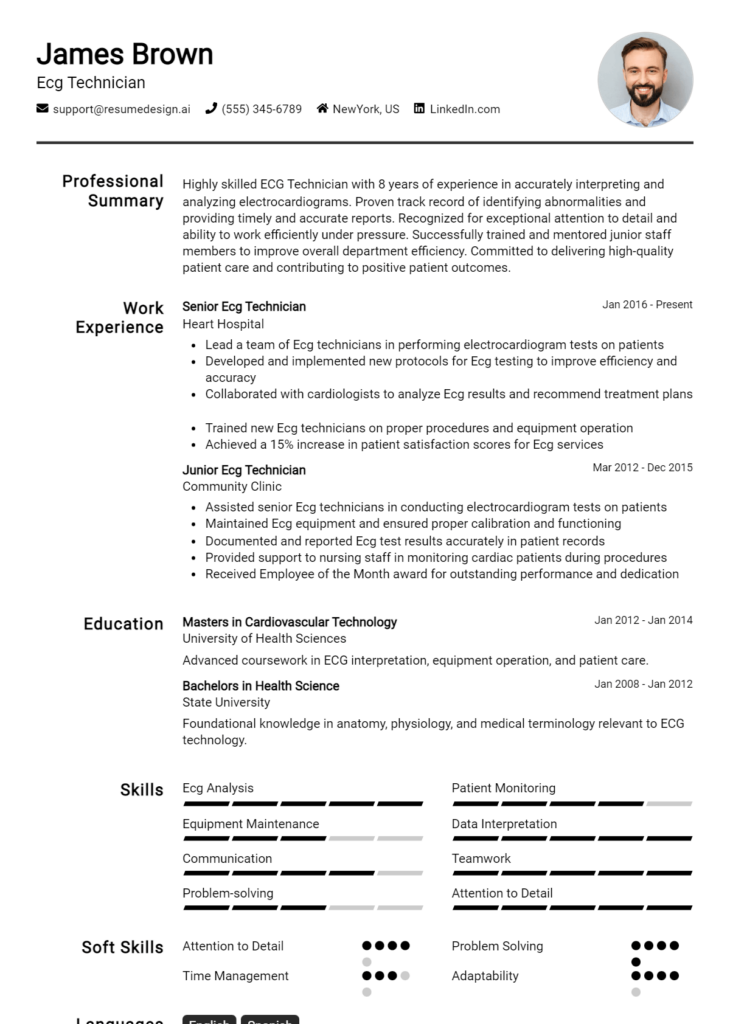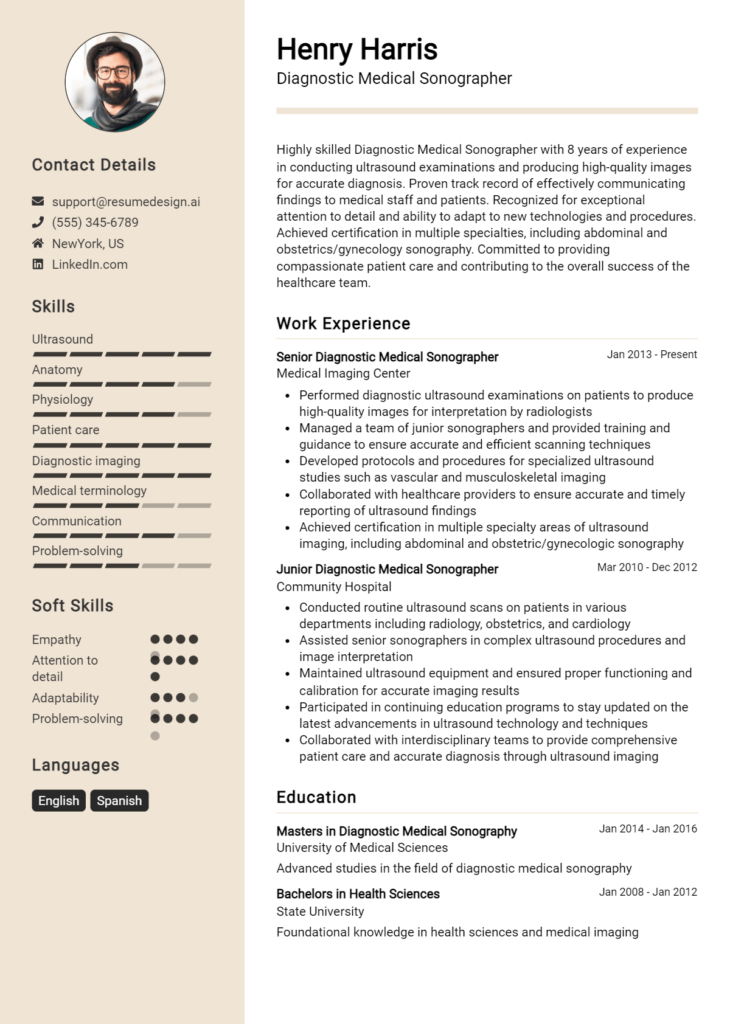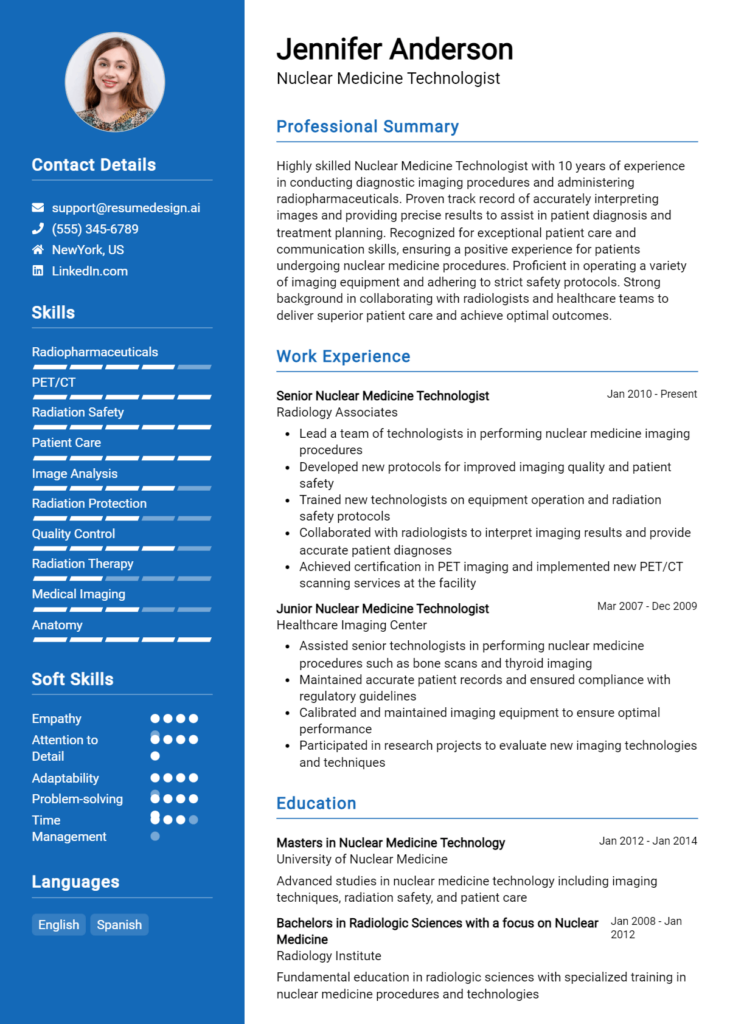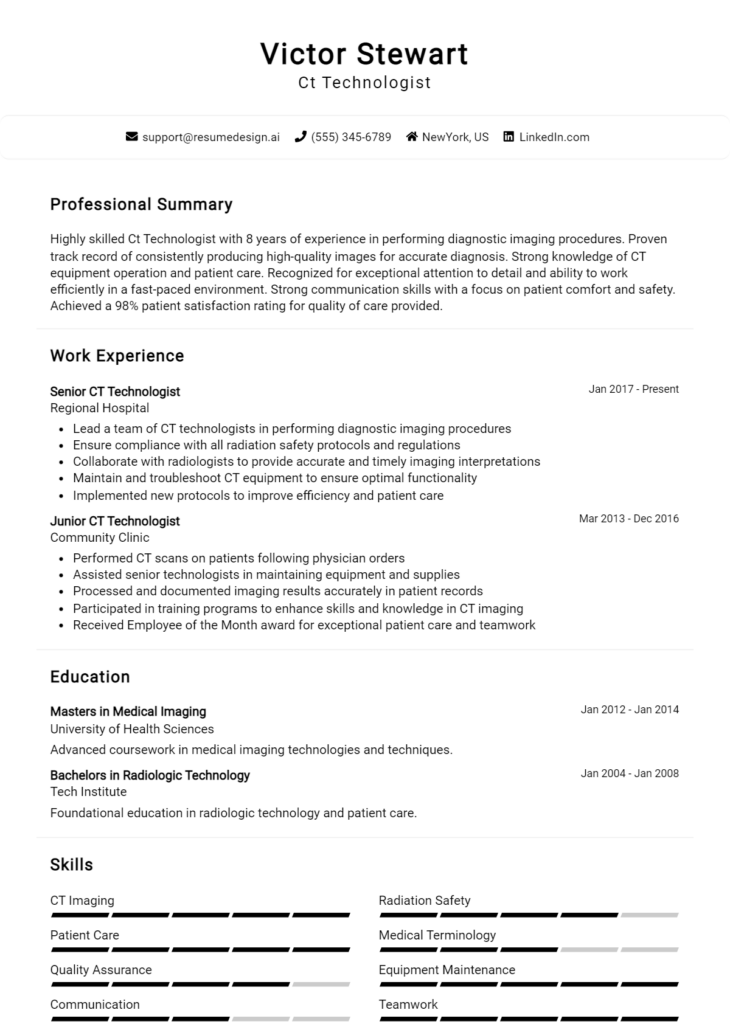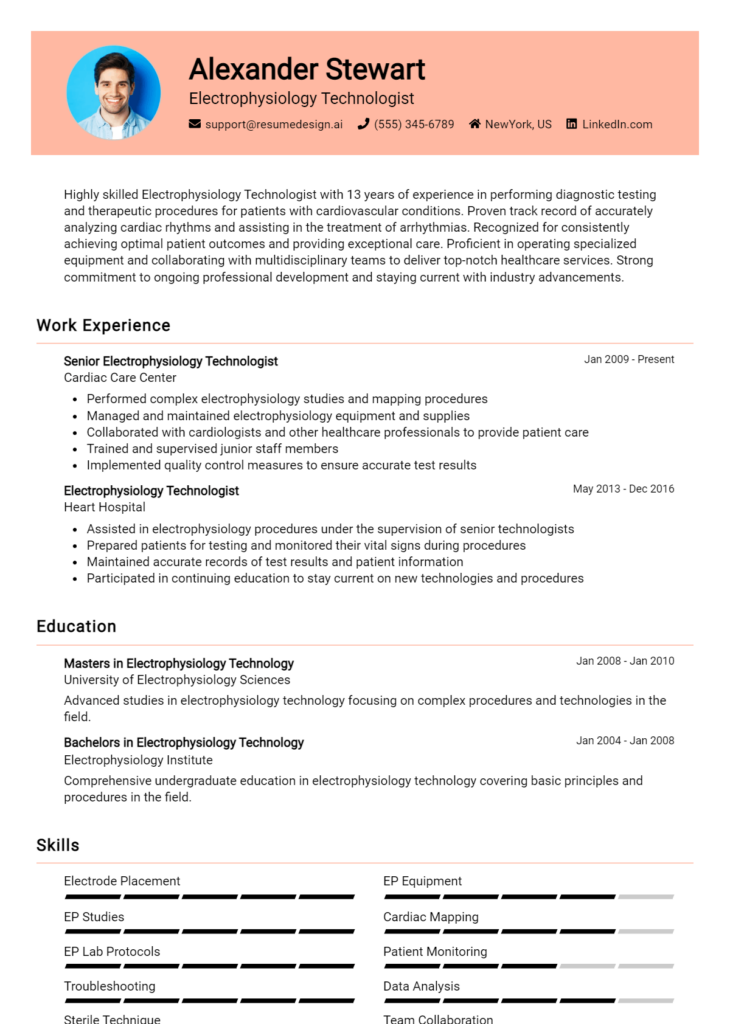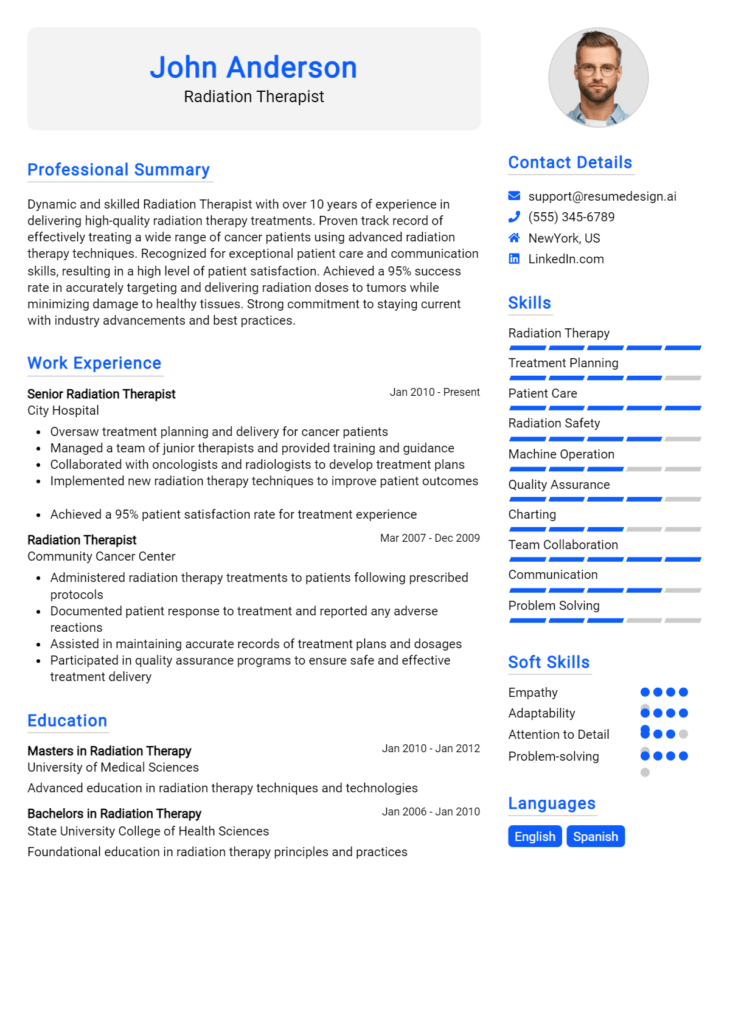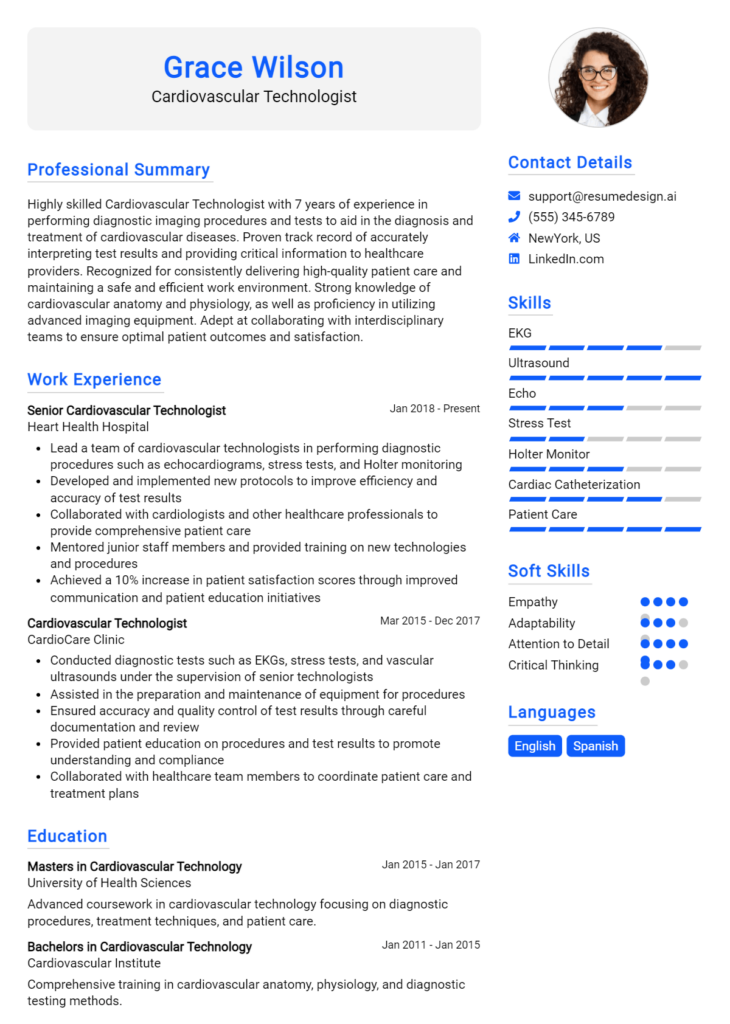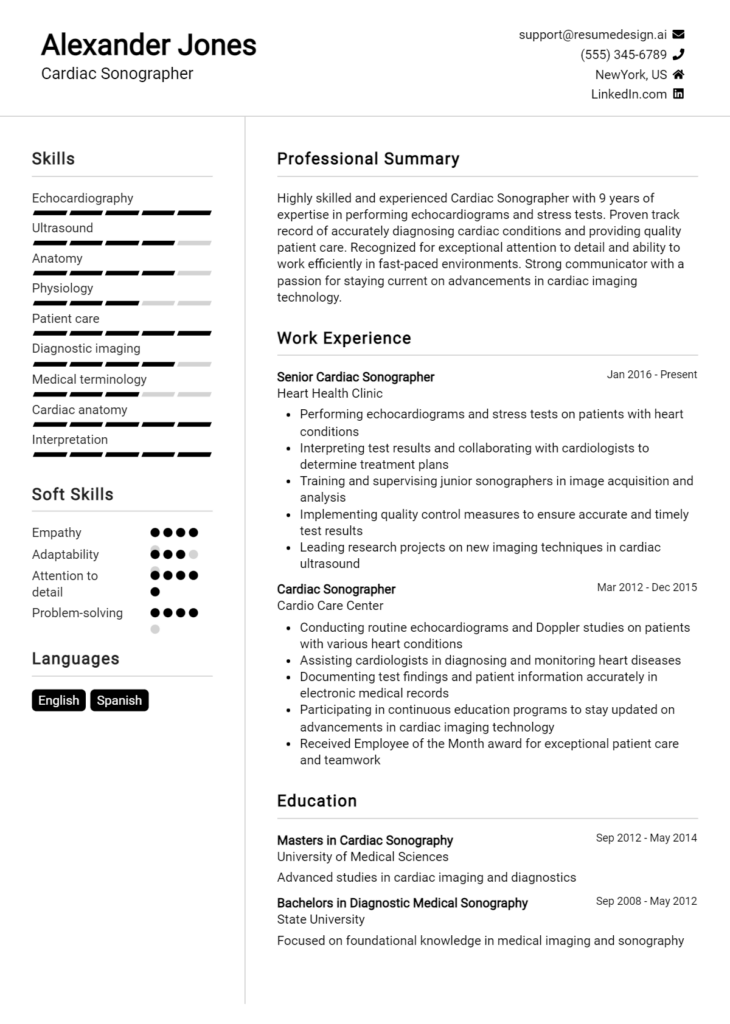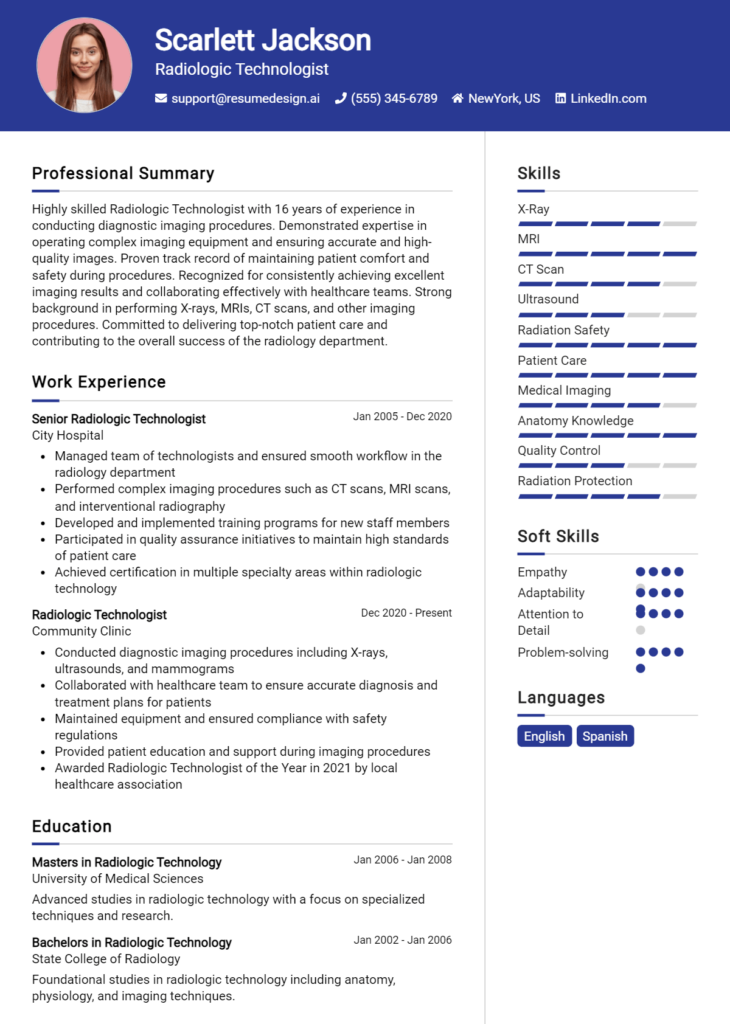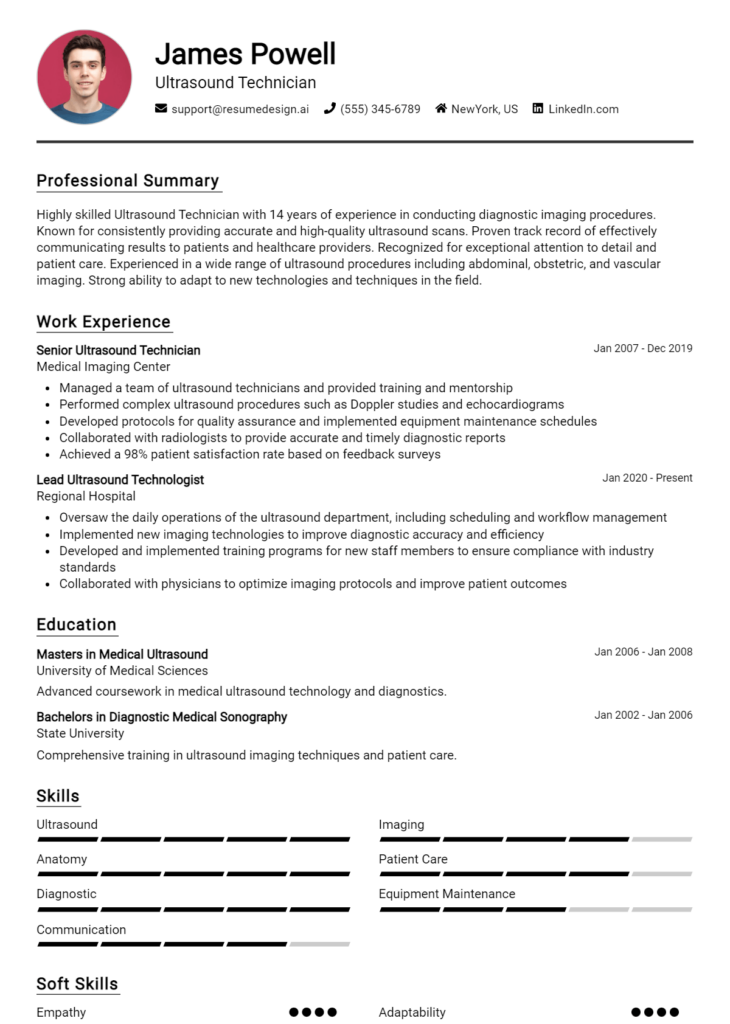Respiratory Care Practitioner Core Responsibilities
Respiratory Care Practitioners play a crucial role in patient care by assessing, diagnosing, and treating individuals with respiratory disorders. They collaborate with physicians, nurses, and other healthcare professionals, bridging various departments to ensure comprehensive care. Technical expertise in equipment operation, operational efficiency, and strong problem-solving skills are essential for success. These abilities not only enhance patient outcomes but also align with the organization’s goals. A well-structured resume can effectively highlight these qualifications, showcasing the practitioner's value in the healthcare team.
Common Responsibilities Listed on Respiratory Care Practitioner Resume
- Administer oxygen therapy and aerosol medications to patients
- Conduct pulmonary function tests and interpret results
- Monitor patients' vital signs and respiratory status
- Educate patients and families on respiratory health and treatments
- Collaborate with medical teams to develop patient care plans
- Maintain and troubleshoot respiratory care equipment
- Assist in emergency situations, including intubation
- Document patient care activities and progress in medical records
- Participate in quality assurance and performance improvement initiatives
- Stay updated with advancements in respiratory care practices
- Train and mentor new staff and students in respiratory procedures
High-Level Resume Tips for Respiratory Care Practitioner Professionals
In the competitive field of respiratory care, a well-crafted resume serves as a vital tool for professionals seeking to make a lasting impression on potential employers. This document is often the first touchpoint between a candidate and a hiring manager, making it essential that it not only reflects the applicant's skills and achievements but also resonates with the specific needs of the employer. A compelling resume can effectively showcase a practitioner’s qualifications, experience, and passion for the profession, setting the stage for successful interviews and career advancement. This guide will provide practical and actionable resume tips specifically tailored for Respiratory Care Practitioner professionals, ensuring they stand out in a crowded job market.
Top Resume Tips for Respiratory Care Practitioner Professionals
- Tailor your resume to the job description by incorporating relevant keywords and phrases that reflect the specific qualifications required by the employer.
- Highlight your relevant experience in respiratory care, including internships, clinical rotations, and any specialized training.
- Quantify your achievements by including metrics such as the number of patients treated, improvements in patient outcomes, or efficiency gains in procedures you implemented.
- Showcase industry-specific skills, such as proficiency in ventilator management, patient assessment, and familiarity with respiratory therapy protocols.
- Include certifications and licenses prominently, ensuring that they are up-to-date and relevant to the position you are applying for.
- Utilize action verbs to describe your professional responsibilities and accomplishments, making your contributions sound impactful and dynamic.
- Incorporate a summary statement at the top of your resume that succinctly encapsulates your career goals and what you bring to the table as a Respiratory Care Practitioner.
- Keep your resume concise and focused, ideally fitting onto one page while still ensuring it covers all necessary details.
- Proofread for grammar and spelling errors, as professionalism in your resume reflects your attention to detail in patient care.
- Consider including a section for continuing education or professional development to show your commitment to staying current in the field.
By implementing these tips, Respiratory Care Practitioner professionals can significantly enhance their resumes, increasing their chances of landing a job in this vital healthcare field. A polished and targeted resume not only showcases one's qualifications but also demonstrates a proactive approach to career development, making candidates more appealing to potential employers.
Why Resume Headlines & Titles are Important for Respiratory Care Practitioner
In the competitive field of respiratory care, crafting an effective resume is crucial for making a strong first impression. A well-crafted resume headline or title serves as a powerful introduction that can immediately capture the attention of hiring managers. It encapsulates a candidate's key qualifications and expertise in a concise and impactful phrase. A strong headline should be relevant to the role being applied for, succinctly summarizing the candidate's skills and experience, thereby setting the tone for the rest of the resume. When done correctly, it enhances the candidate's visibility and increases the likelihood of advancing to the interview stage.
Best Practices for Crafting Resume Headlines for Respiratory Care Practitioner
- Keep it concise: Limit your headline to one sentence or a brief phrase.
- Be role-specific: Use keywords that reflect the position you are applying for.
- Highlight key qualifications: Focus on your strongest skills or experiences relevant to respiratory care.
- Use action-oriented language: Start with action verbs to convey confidence and proactivity.
- Avoid jargon: Ensure the language is clear and accessible to all hiring managers.
- Tailor for each application: Customize your headline for different job postings to align with specific requirements.
- Include measurable achievements: If possible, quantify your accomplishments to add impact.
- Reflect your professional identity: Make sure your headline aligns with your career goals and aspirations.
Example Resume Headlines for Respiratory Care Practitioner
Strong Resume Headlines
Dedicated Respiratory Care Practitioner with 5+ Years of Experience in Critical Care Settings
Certified Respiratory Therapist Specializing in Pediatric Care and Advanced Ventilation Techniques
Compassionate Respiratory Care Specialist Committed to Enhancing Patient Outcomes through Evidence-Based Practices
Weak Resume Headlines
Respiratory Care Professional
Experienced in Healthcare
The strong headlines effectively convey specific qualifications and areas of expertise, making it clear to hiring managers what the candidate brings to the table. They use strong adjectives and precise language that aligns with the responsibilities of a respiratory care practitioner. In contrast, the weak headlines lack specificity and fail to differentiate the candidate from others, making them less memorable and impactful. By avoiding vague terms and highlighting relevant skills, candidates can significantly improve their chances of capturing attention in a crowded applicant pool.
Writing an Exceptional Respiratory Care Practitioner Resume Summary
A resume summary is a vital component for a Respiratory Care Practitioner, as it serves as the first impression for hiring managers. A well-crafted summary quickly captures attention by showcasing key skills, relevant experience, and notable accomplishments that align with the job role. It should be concise and impactful, providing a snapshot of the candidate's qualifications while being tailored specifically to the position they are applying for. This allows hiring managers to immediately recognize the candidate's potential value to their team and organization.
Best Practices for Writing a Respiratory Care Practitioner Resume Summary
- Quantify Achievements: Use numbers and statistics to demonstrate your impact, such as the number of patients treated or improvements in patient outcomes.
- Focus on Skills: Highlight both technical and soft skills relevant to respiratory care, such as patient assessment, critical thinking, and communication abilities.
- Tailor the Summary: Customize your summary for each job application by incorporating keywords and phrases from the job description.
- Be Concise: Aim for 3-5 sentences that succinctly summarize your qualifications and what you bring to the role.
- Highlight Certifications: Include any relevant certifications, such as RRT (Registered Respiratory Therapist) or CRT (Certified Respiratory Therapist), to establish credibility.
- Showcase Experience: Quickly outline your years of experience in the field and the types of settings in which you have worked, such as hospitals or outpatient clinics.
- Emphasize Patient Care: Mention your commitment to delivering high-quality patient care and improving patient outcomes.
- Use Action Verbs: Start sentences with strong action verbs to convey a sense of proactivity and engagement in your role.
Example Respiratory Care Practitioner Resume Summaries
Strong Resume Summaries
Dedicated Respiratory Care Practitioner with over 5 years of experience in acute care settings, skilled in patient assessment and mechanical ventilation management. Achieved a 20% improvement in patient recovery times through the implementation of evidence-based respiratory protocols.
Compassionate and detail-oriented Respiratory Therapist with a proven track record of managing complex cases in NICU and adult ICU environments. Certified RRT with expertise in pulmonary rehabilitation, successfully enhancing patient outcomes for over 150 individuals through tailored therapy programs.
Results-driven Respiratory Care Practitioner with a focus on patient-centered care and a history of reducing hospital readmission rates by 15%. Proficient in performing diagnostic tests and delivering high-quality respiratory therapies in multidisciplinary teams.
Weak Resume Summaries
Experienced Respiratory Care Practitioner looking for a new opportunity. I have worked in various healthcare settings and am familiar with respiratory equipment.
Respiratory Therapist with some experience. I am a team player and want to help patients with their breathing problems.
The examples provided illustrate the differences between strong and weak resume summaries. Strong summaries effectively quantify achievements and showcase specific skills relevant to the role, making them impactful and memorable. In contrast, weak summaries lack detail, are overly generic, and fail to convey the candidate's unique qualifications or contributions, which diminishes their effectiveness in catching the hiring manager's attention.
Work Experience Section for Respiratory Care Practitioner Resume
The work experience section of a Respiratory Care Practitioner resume is crucial as it serves as a comprehensive showcase of the candidate's technical skills, leadership abilities, and commitment to delivering high-quality patient care. This section not only highlights practical experience in respiratory therapy but also illustrates the capability to manage teams effectively and implement best practices in clinical settings. By quantifying achievements and aligning experiences with industry standards, candidates can demonstrate their value to potential employers, making them more competitive in the job market.
Best Practices for Respiratory Care Practitioner Work Experience
- Begin each bullet point with action verbs to convey proactivity and impact.
- Quantify achievements where possible, such as the number of patients treated or improvements in patient outcomes.
- Highlight technical expertise in specific respiratory care technologies and procedures.
- Include examples of collaboration with interdisciplinary teams to improve patient care.
- Showcase leadership roles taken, such as training new staff or leading initiatives.
- Tailor experience descriptions to align with the job description and industry standards.
- Utilize concise language that focuses on results and contributions.
- Incorporate relevant certifications and specialized training within the context of work experience.
Example Work Experiences for Respiratory Care Practitioner
Strong Experiences
- Implemented a new ventilation protocol that reduced patient intubation rates by 20% over six months.
- Led a team of 5 respiratory therapists to develop a comprehensive patient education program, increasing patient understanding of respiratory conditions by 40%.
- Conducted quality assurance audits that improved compliance with best practice guidelines by 30% across the department.
- Collaborated with cross-functional teams to optimize respiratory care workflows, resulting in a 15% increase in patient throughput.
Weak Experiences
- Worked as a respiratory therapist in a busy hospital.
- Assisted in various patient care tasks.
- Participated in meetings about departmental goals.
- Helped with equipment maintenance and checks.
The examples labeled as "strong" illustrate specific, quantifiable achievements and demonstrate leadership and collaboration, making them impactful and relevant to potential employers. In contrast, the "weak" experiences lack detail and specificity, failing to convey the candidate's contributions or the results of their efforts. This distinction emphasizes the importance of articulating concrete outcomes and responsibilities in the work experience section of a resume.
Education and Certifications Section for Respiratory Care Practitioner Resume
The education and certifications section of a Respiratory Care Practitioner resume is vital as it effectively showcases the candidate's academic foundation, industry-relevant credentials, and commitment to continuous professional development. This section not only reflects the level of expertise and knowledge in respiratory care but also highlights specialized training and coursework that can distinguish candidates in a competitive job market. By providing detailed information about relevant degrees and certifications, candidates can enhance their credibility and demonstrate their alignment with the specific requirements of the job role.
Best Practices for Respiratory Care Practitioner Education and Certifications
- Prioritize relevant degrees, such as an Associate’s or Bachelor’s in Respiratory Therapy.
- Include detailed information about industry-recognized certifications, such as RRT (Registered Respiratory Therapist) or CRT (Certified Respiratory Therapist).
- Highlight any specialized training in advanced respiratory care techniques or equipment.
- List relevant coursework that directly pertains to respiratory care practices, such as pathophysiology or pulmonary rehabilitation.
- Indicate the dates of certification renewals to show ongoing education and compliance with industry standards.
- Feature memberships in professional organizations, such as the American Association for Respiratory Care (AARC), to reflect commitment to the field.
- Use clear formatting and organization to make this section easy to read and navigate.
- Tailor this section to match the specific requirements and keywords mentioned in the job description.
Example Education and Certifications for Respiratory Care Practitioner
Strong Examples
- Bachelor of Science in Respiratory Therapy, University of Health Sciences, Graduated May 2022
- Registered Respiratory Therapist (RRT), National Board for Respiratory Care, Certification #: 123456, Expires: March 2025
- Advanced Cardiac Life Support (ACLS) Certification, American Heart Association, Completed: January 2023
- Coursework in Neonatal and Pediatric Respiratory Care, University of Health Sciences
Weak Examples
- Associate Degree in General Studies, Community College, Graduated May 2015
- Basic Life Support (BLS) Certification, Completed: 2019 (Outdated for respiratory care professionals)
- Certificate in Home Health Aide, Completed: June 2020
- Online Course in Stress Management, Completed: August 2021
The strong examples are considered robust because they directly align with the qualifications and competencies necessary for a Respiratory Care Practitioner, showcasing relevant education, recognized certifications, and pertinent coursework. In contrast, the weak examples reflect qualifications that do not pertain to respiratory care, with outdated certifications and unrelated coursework that fails to demonstrate the candidate's commitment or expertise in the field.
Top Skills & Keywords for Respiratory Care Practitioner Resume
As a Respiratory Care Practitioner, showcasing the right skills on your resume is crucial for standing out in a competitive job market. Employers look for candidates who not only possess the necessary technical expertise but also demonstrate strong interpersonal abilities. Highlighting both hard and soft skills can effectively convey your qualifications and suitability for the role. By focusing on these key competencies, you can better position yourself as a valuable asset to healthcare teams dedicated to improving patient respiratory health.
Top Hard & Soft Skills for Respiratory Care Practitioner
Soft Skills
- Effective Communication
- Empathy and Compassion
- Team Collaboration
- Problem-Solving
- Attention to Detail
- Time Management
- Adaptability
- Critical Thinking
- Patient Education
- Stress Management
- Active Listening
- Conflict Resolution
- Interpersonal Skills
- Cultural Competence
- Professionalism
Hard Skills
- Knowledge of Respiratory Therapies
- Proficiency in Using Respiratory Equipment
- Patient Assessment Skills
- Emergency Response Techniques
- Mechanical Ventilation Management
- Pulmonary Function Testing
- ABG (Arterial Blood Gas) Analysis
- Knowledge of CPR and Advanced Life Support
- Familiarity with Electronic Medical Records (EMR)
- Understanding of Pharmacology Related to Respiratory Care
- Interpretation of Chest X-rays
- Knowledge of Disease Management Protocols
- Quality Control and Safety Standards
- Data Collection and Analysis
- Research and Evidence-Based Practice
- Clinical Documentation
- Patient Management Systems
For a deeper understanding of how to effectively showcase these skills and highlight your relevant work experience, consider tailoring your resume to reflect both your technical capabilities and your interpersonal strengths.
Stand Out with a Winning Respiratory Care Practitioner Cover Letter
Dear [Hiring Manager's Name],
I am writing to express my interest in the Respiratory Care Practitioner position at [Company Name] as advertised on [where you found the job listing]. With a Bachelor’s degree in Respiratory Therapy and over [X years] of hands-on experience in various clinical settings, I am confident in my ability to contribute effectively to your team and provide high-quality care to patients with respiratory conditions. My comprehensive knowledge of respiratory care, coupled with my dedication to patient-centered service, positions me as a strong candidate for this role.
Throughout my career, I have developed a robust clinical skill set that includes performing diagnostic tests, administering therapies, and educating patients about their respiratory health. At [Previous Employer], I was responsible for managing a diverse caseload of patients, where I collaborated closely with physicians and other healthcare professionals to create and implement individualized treatment plans. My commitment to staying current with advancements in respiratory care has enabled me to enhance patient outcomes through evidence-based practices. Additionally, my strong communication skills allow me to build rapport with patients, ensuring they feel supported and informed during their treatment journeys.
I am particularly impressed by [Company Name]'s commitment to [specific value or initiative of the company]. I share your passion for [relevant aspect of the company's mission], and I believe my proactive approach and compassionate nature will align well with your team’s goals. I am eager to bring my expertise in respiratory care to [Company Name] and contribute to the exceptional care you provide to your patients.
Thank you for considering my application. I look forward to the opportunity to discuss how my background, skills, and enthusiasms can benefit [Company Name]. I am excited about the possibility of joining your dedicated team and contributing to the outstanding patient care you are known for.
Sincerely,
[Your Name]
[Your Contact Information]
Common Mistakes to Avoid in a Respiratory Care Practitioner Resume
When crafting a resume as a Respiratory Care Practitioner, it's crucial to present your skills and experiences effectively to stand out in a competitive job market. However, many applicants make common mistakes that can diminish their chances of landing an interview. By being aware of these pitfalls, you can refine your resume and highlight your qualifications in the best possible light.
Neglecting Relevant Certifications: Failing to prominently display certifications such as RRT or CRT can lead to missed opportunities, as employers often prioritize these credentials.
Using Generic Language: Avoid vague terms and phrases. Specificity in describing your roles and achievements makes your resume more compelling and memorable.
Ignoring Tailoring for Each Application: Sending out a one-size-fits-all resume can be detrimental. Tailor your resume to match the job description and highlight relevant experiences for each application.
Lack of Quantifiable Achievements: Simply listing job duties without quantifying your contributions (e.g., improved patient outcomes by 20%) can make your resume less impactful.
Overemphasizing Job Duties: Focus more on your achievements and the impact you had in previous roles rather than just listing your responsibilities. Employers want to see how you added value.
Poor Formatting Choices: Using overly complicated formats or fonts can make your resume hard to read. Stick to a clean, professional layout that highlights key information effectively.
Omitting Soft Skills: While technical skills are crucial in respiratory care, soft skills such as communication and teamwork are equally important. Be sure to include relevant interpersonal abilities.
Not Proofreading for Errors: Typos and grammatical mistakes can create a negative impression. Thoroughly proofread your resume or have someone else review it to ensure it is error-free.
Conclusion
As a Respiratory Care Practitioner, you play a vital role in the healthcare system, providing essential care to patients with respiratory conditions. Throughout this article, we explored the intricacies of the profession, including the critical skills required, the importance of staying updated with the latest treatment techniques, and the opportunities for career advancement. We also discussed the various settings in which you could work, from hospitals to home care, and how each environment presents unique challenges and rewards.
Now, as you reflect on your career journey and consider the next steps, it's crucial to ensure that your resume accurately reflects your skills, experiences, and accomplishments. A well-crafted resume can set you apart from other candidates and highlight your qualifications effectively.
To assist you in this process, consider utilizing the variety of resources available to enhance your job application materials. Explore our resume templates for a professional layout that suits your style. You can also take advantage of our resume builder for a user-friendly experience that guides you in crafting a standout resume. If you're looking for inspiration, check out our extensive collection of resume examples tailored for respiratory care professionals. Additionally, don’t forget to pair your resume with a strong cover letter; our cover letter templates can help you make a compelling case for your candidacy.
Take action today—review your resume and utilize these tools to ensure you're presenting your best self to potential employers. Your next opportunity is just around the corner!

